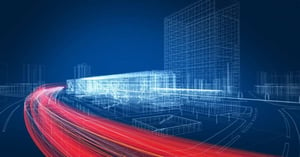Cities are both a key enabler of productivity and economic development, and essential to the social and political wellbeing of individuals and society, as the place that most people now call ‘home’.
However, there are many problems in cities that are inhibiting economic growth and social and environmental justice and equality. Traffic congestion is a huge problem worldwide and costs national economies billions of pounds each year. In the UK alone, traffic cost the economy £31bn in 2016. Poor housing conditions, leading to greater need for healthcare services, also put a huge strain not only on people’s lives but also on local and national healthcare systems. Growing populations and changing demographics - for example, an increasingly youthful population in many African cities, and an increasingly ageing population in much of Europe - is already beginning to put a lot of strain on public services and the built environment. The global housing crisis is just one expression of this.
The smart city concept is one reaction to the growing challenges that urban centers face - from environmental degradation, to increasing economic inequalities, to growing populations that overstrain and exhaust social and physical infrastructure - as it aims to improve the operational, service and energy efficiency of cities and render them better places to live for all.
BIM and the smart city are intertwined: BIM can be seen as one smart city ‘tool’, offering huge potential to help cities deal with the challenges that growing urbanization poses through improving their operational efficiency, facilitating multi-stakeholder cooperation and cutting costs. BIM seeks to address many of the societal issues that cities are currently facing: the impacts of climate change, ageing infrastructure, housing affordability, traffic growth and congestion, lack of communication or cooperation between different industries, and much more.
Despite the huge opportunities BIM offers cities, however, research suggests that municipal authorities are not really adopting it: instead, it is largely being deployed at the national level. This is perhaps because some see BIM as specifically enabling the digitization of the construction industry, where the smart city concept separately enables the digitization of the city. However, BIM is at the core of the smart city, in that it fosters improvements in energy and cost-efficient buildings, facilitating more sustainable urban development, and is key to tackling many of the challenges mentioned above.
CIM (city information modelling), a relatively new adaptation of BIM technologies, goes one step further than BIM, integrating the information provided by BIM into wider city planning and development. The economic, social and environmental benefits of integrating BIM at different spatial scales within the city, whether as part of individual construction projects or as CIM, are explored below:
Centralizing information and placing it in context
BIM (Building Information Modelling) allows architects, builders and designers to manage the entire project life-cycle of any infrastructure or building construction - from its inception and design to its eventual or potential demolition and the reuse of its materials - in one place. Spaces, systems, products and sequences are shown in relative scale to each other and the entire project. CIM covers a wider area, allowing for infrastructure (whether already built, or in the construction or design phase) to be modelled in accurate geospatial contexts at the city-level.
Anyone working on a project using BIM or CIM can access information about any aspect of the infrastructure being built and use it for any purpose - whether finding out property-specific information about a material being used or modelling an alteration to the original plan. BIM is thus in some senses a platform, not only allowing all stakeholders to access all they key information about a project in one place, but also to accurately model the project in its local context.
Increasing collaboration and cooperation
BIM is a collaborative tool that facilitates cooperation and enables better information-sharing and management and communication between the different teams involved in a construction project. All teams contribute information and benefit from the information inputted by others: silos are therefore eliminated. This system ‘democratizes’ knowledge and allows for more collective decision-making. BIM’s common language and common semantics therefore allows service providers to collaborate across complex projects across the city, and also means that all team members are working to the same standards.
The smart 3D models enabled by BIM encourage the harmonization of services; a lot of the geospatial data involved in these models is constantly being collected from sensors planted everywhere - on infrastructure, CCTV cameras, throughout the road network - although it is of course combined with existing GIS datasets for even more context. Aggregating and using data from different areas of the city - and different public service departments - fosters a working-together approach, allowing not only the coordinated design of individual buildings, but also of whole districts, facilitating integrated services and coordinated maintenance programs for certain assets.
Minimizing risk
When building public infrastructure - whether a road, tunnel, bridge, or building - the risks are significant. Creating models of the environments that new projects will be placed in, through BIM and CIM, allows you to test out the project both before and during the construction process, serving as a kind of ‘digital twin’ or virtual ‘proof of concept’ stage. This is particularly important when it comes to risk: through BIM, any potential errors or incidents can be flagged up well before anything can actually go wrong. Currently CIM is already used by the insurance and industry to assess the impact of natural disasters, such as floods, earthquakes or storm events, on buildings and districts; city councils and other companies can use it for the same purpose. This kind of scenario modelling allows for an analysis of the impact of certain events on existing assets and, in turn, its impact on public safety.
Empowering citizens
BIM and/or CIM collects data into one platform that can be shared among all - this includes the public. Not much BIM is currently open-source, but in the cases where it is, it allows the community to fully engage in the physical transformation of their city, giving them access to information usually only held by those directly involved in the design and construction process. This openness can also be used to facilitate the creation of mobile apps, for example Toolz, a virtual reality map which offers models of urban areas which can be adapted virtually by the community to ‘test’ out urban design solutions. The possibilities for community engagement offered by BIM/CIM have not yet been explored fully. Although, as it stands, the different type of projects that can be delivered through BIM - that provide and coordinate real-time data about the whole city, and key infrastructure within it - offer cities lots of opportunities to link different planning approaches and different citizen uses and needs.
Improving productivity, efficiency and results
In traditional building processes, key project and asset knowledge is often lost between stages, when one team hands over to another; BIM stops this from happening by centralizing all information, so that all resources are shared, and standardizing procedures and benchmarks. This way, expertise is consistent and consolidated, and all relevant information and errors are integrated into one platform so that they can be solved systematically by developers and management. This then allows them to conduct performance analysis more effectively and carry out more accurate assessments of the condition of the involved assets - seeing exactly how the buildings at hand are operating and where any efficiencies can be made, enabling better usage and utilization of assets and resources.
Sharing resources and increasing cooperation not only saves time and money and optimizes results, it also consequently improves public services through better integrating them with real time information and analysis - a key feature of the smart city. Greater coordination across community stakeholders and different governmental departments also means that local projects and initiatives can be better deployed. This can be seen with San Francisco’s Smart Park system, where coordination across city departments under the umbrella of one tool (the smart parking solution that collects data from parking spaces and other city infrastructure, includes smart parking meters and payment services, and more) has allowed the city to implement a flexible demand-response pricing model for parking that both works for the city (cutting down parking fraud, gathering more data, cutting carbon emissions) and citizens (making it easier to pay for parking, or cheaper if they choose certain spots or time of the day).
Making cities more environmentally and socially sustainable
Aside from the economic benefits of BIM, mentioned above, there are also social and environmental benefits. Cities want to use data to orchestrate their communities’ quality of life, and their safety and security, above and beyond economic opportunity; BIM and CIM offer them a way to do this. For instance, more accurate ordering of materials, enabled through BIM, would lead to less waste going to landfill; or, optimized simulation of energy analysis, especially across whole districts, would lead to lower energy demands from the built environment and help lower greenhouse gas emissions. The streamlining of the construction process, and the ability to visualize how a whole building or city ecosystem is functioning in real-time, also allows those managing these systems (whether micro or macro) to adjust resource and energy-usage accordingly, or set up flexible models of consumption that respond to trends that longer-term data reflects. BIM can have social impacts too; as we saw above, it can be used as one tool for engaging the public and communities in the assessment of their future built environment needs, helping local authorities to make better decisions concerning planned infrastructure investment, building design and location.
Conclusion
Some pioneer cities have gone beyond simply using BIM and are now experimenting with using intelligent modelling for city development. The shift towards digitizing the whole city - infrastructure and all - is opening up new opportunities to link urban planning and urban design with BIM. CIM is the next step: developing a digital DNA of cities, or a ‘digital twin’. CIM can be used to provide simulation of traffic flows, congestion, energy use and provision, smart grids, and much, much more.
So, how do we accelerate the adoption of BIM and CIM in our smart cities? In general, the research suggests that creating a governmental framework and a set of more concrete standards is really important for the development of BIM. The momentum of smart cities strategies could also be exploited more to make better use of BIM; this might be done through emphasizing the potential of CIM and the opportunity it offers to link different data sets from BIM modelled construction sites in order to facilitate wider city development.
 “Whatever happens, the digitization of cities and their services is at the heart of the smart cities concept, and this digitization will rely heavily on BIM and CIM as we move into the future. BIM technologies will only become a greater enabler of the smart city, and, in time, will hopefully help to accelerate smart planning and connectivity for more livable, sustainable, and interconnected cities!", states Bart Gorynski, Managing Partner of bee smart city.
“Whatever happens, the digitization of cities and their services is at the heart of the smart cities concept, and this digitization will rely heavily on BIM and CIM as we move into the future. BIM technologies will only become a greater enabler of the smart city, and, in time, will hopefully help to accelerate smart planning and connectivity for more livable, sustainable, and interconnected cities!", states Bart Gorynski, Managing Partner of bee smart city.
Register for smart city solutions & smart building technologies!
bee smart city is leveraging the power of new technologies and collective intelligence to make our cities and communities more citizen-centric places through its global smart city solution database. Add your favorite solution today, and contribute to sharing smart solutions together with thousands of other smart city enthusiasts.


